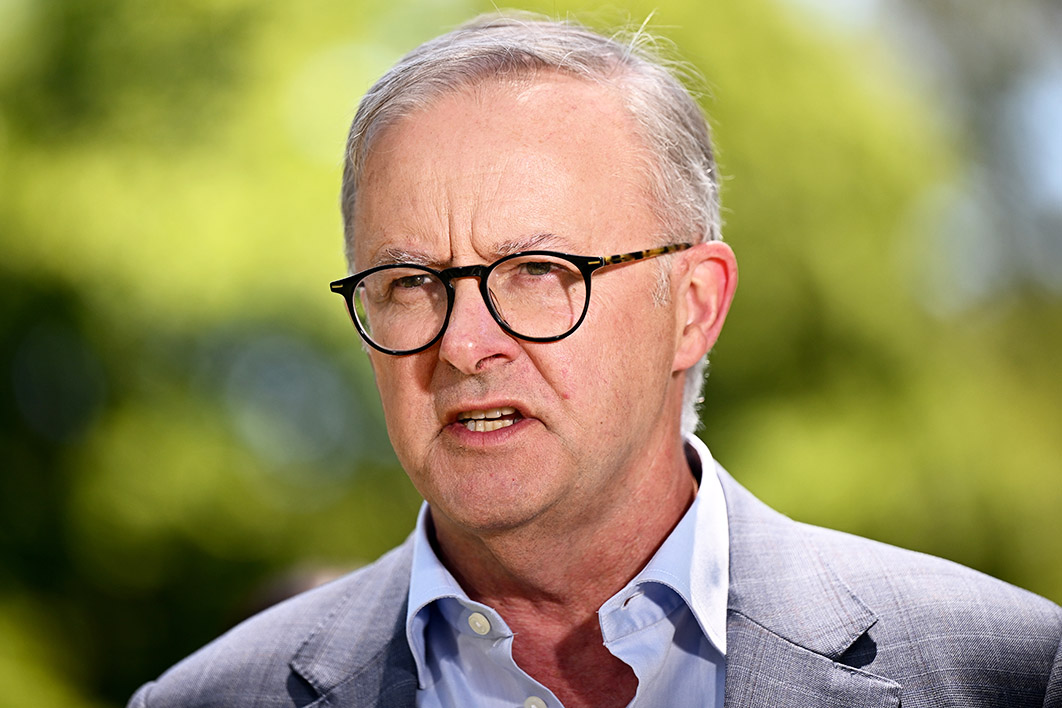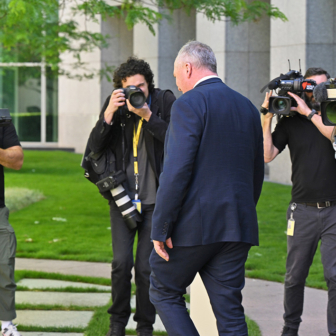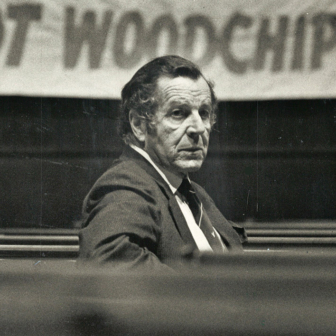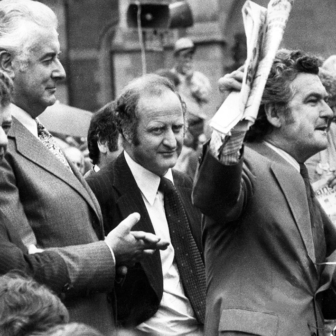Opposition leader Peter Dutton’s first priority — yesterday, today and every day — is to remain in his job until the next election. Everything else (including, if push comes to shove, actually winning that election) is subservient to that. His manoeuvres on the Voice are best seen through that prism: managing his party room and the wider conservative movement and keeping himself as much as possible out of hot water.
Of course if he really, earnestly had questions about the upcoming referendum he could have picked up the phone to the prime minister, or quietly emailed him, rather than send the list to News Corp journalists and then the wider public. The Albanese government’s lack of preparation for the onslaught that followed was evident to all.
Some of Dutton’s fifteen questions deal with the proposed constitutional changes; most go to the subsequent legislation. One of them — “Is it purely advisory, or will it have decision-making capabilities?” — seems to have been answered ad nauseum, in the negative; it can only advise parliament. But the full answer might depend on what “decision-making capabilities” means — the decision to hold a meeting, perhaps?
Can’t give a simple response? Gotcha! Welcome to the politics of advocating change.
The chief problem these questions create for the government and perhaps all Voice advocates is that no one knows the exact answers to most of them. The Voice wasn’t the government’s idea; it came from the First Nations National Constitutional Convention, and the proposal was for a referendum to set up the mechanism, broadly, in the Constitution, after which parliament would thrash out the details via committees and public hearings including, particularly, input from Indigenous groups and individuals.
In the same mischief-making vein sits the demand for draft legislation — now! Of course, unilaterally pre-empting the consultation process would alienate Indigenous groups. It would be picked apart by opponents. It would just be wrong, and ultimately fraudulent, as the government could not promise it wouldn’t be changed, because of course it would be.
How many worlds can you have the worst of?
So Dutton’s “questions” have worked a treat — particularly among the Coalition’s favourite media outlet — with headlines about a campaign in disarray. (It’s not wall-to-wall disingenuity at News Corp; there’s a good summary of the issues by James Campbell in the tabloids.)
Still, the government’s best response would be to provide written, detailed, publicly available answers to the questions. Few will read them, of course, and journalists will still demand succinct three-sentence explanations and tut-tut about the referendum’s chances when they’re not delivered. But at least they will have something to point to.
Some are citing these recent developments as evidence that it was a blunder to propose a change that leaves the details to parliament. But the alternative, trying to define every nut and bolt beforehand, would have been even worse politically — a huge target for opponents to rummage through — and an inherently terrible idea, because like any public arrangements it will need ongoing tweaking.
And seriously, did anyone really think the federal opposition would offer bipartisan support? Expecting that would ignore the constraints within which Dutton is operating.
Right back when the two-party system developed in the second decade after Federation, Labor and non-Labor attitudes to constitutional amendments per se took hold at DNA level. I’ve written before, and again, that Liberal opposition leaders (as opposed to prime ministers) simply lack the authority to support Labor government referendums, even the most benign. A textbook case can be found in 2013, when a party-room revolt forced Tony Abbott to withdraw support for constitutional recognition of local government.
Sometimes the Liberals end up proposing the same (or similar) when they’re in power; see “Simultaneous Elections” under Labor in 1974 and the Coalition in 1977.
And the Voice is inherently more likely to provoke antagonism among Liberal parliamentarians, and more so among the membership. (And the Nationals, of course, have already nailed their colours to the mast.)
So expecting Dutton to go down in history as the Liberal leader who transcended partisan dynamics to reach across the aisle to support meaningful constitutional recognition, only to be later humiliatingly forced to backtrack by his fellow MPs, was always a fantasy.
The surprise is that he’s skipped to the chase so early, in the process catching the government off guard. On Saturday shadow Indigenous Australians minister Julian Leeser, a long-time advocate of the Voice, also castigated the government, criticising it at a Young Liberal convention for “not providing the detail” and preposterously adding that “they’re in danger of losing me.” He repeated the warning on ABC RN Breakfast on Monday, adding that he and Dutton were merely passing on questions people had asked them over summer.
It sounds bonkers, but again the realpolitik is unavoidable: Leeser’s leadership has embarked on a certain course and as part of shadow cabinet he must follow. What, again, is the alternative — generate headlines about division?
(By contrast, Senator Andrew Bragg, outside shadow cabinet and probably the loudest Coalition Voice supporter, wrote in the Australian that while he himself was “not confused,” he believes “a parliamentary inquiry should look at the referendum question, the amendment and the scope of the body or bodies to be legislated,” adding optimistically that it would “allow the legitimate legal issues to be investigated and the red herrings dismissed.”)
Actually, by showing his hand so early, Peter Dutton has done the government and Voice advocates a favour, dashing any illusions of an easy bipartisan path to voting day. It’s now obvious that the best that can be hoped for is the Liberals not adopting an official cohesive position.
(The Greens, it seems to me, barely matter. Their official stance will influence few of their supporters, and if they really do come out against the Voice it will probably be a net positive for its prospects in the wider electorate. And this discussion is about the campaign itself. I assume the legislation to enable the referendum will get through parliament one way or another.)
No one said this would be easy. Okay, some people might have been encouraged by opinion polls over recent years showing substantial majority support. But these involved pollsters contacting people, the vast majority of whom had never heard of the Voice, explaining it in benign terms and asking what they thought.
The past fortnight has reminded us that constitutional change is not remotely that easy. High support that crashes by polling day is a feature of, particularly, Labor government–initiated referendums. The Hawke 1988 government’s set of four went from 60s and 70s in May that year to September Yes votes in the 30s. As the No vote climbs, public figures jump on the bandwagon.
Okay, last year’s federal election showed that commentator pontifications about campaigns off the rails tend to be just so much bubble talk. But referendums are different from our lesser-of-two-evils two-party seesaw. It’s likely that the number of Australians who have actually turned their attention to the Voice increased several-fold over the last fortnight, and unlike the aforementioned opinion polling, their introduction to the topic was not favourable.
Indeed, a new poll in News Corp tabloids boasts “new polling showing more than two-thirds of Australians don’t understand the proposal.” The YouGov survey (actually of respondents only in New South Wales) found 46 per cent in favour, 30 per cent opposed and 24 per cent not sure.
The well-known referendum statistic is eight successes from forty-four attempts. The portion of Labor government attempts is starker: twenty-five attempts with just one success. Some of this history of failure is due to Labor’s propensity to be more ambitious, some to the electorate being more likely to be suspicious of Labor’s centralising plans, but overriding it is the aforementioned absence of bipartisanship.
It all ends up as a giant by-election, and we know what usually happens to governments at those.
It’s easy to snipe. I don’t want to be that negative guy. I can’t fault the “campaign” so far because it hasn’t really started, and it’s hard to know what else the government could have done. The opposition’s sudden quasi-No campaign caught everyone off guard. It’s early days.
I’ll be voting Yes because I respect the consultation process and the people who produced the proposal. In statistics alone, the gap between Indigenous Australians and the rest is dire and the status quo untenable. I don’t see our Constitution is so fragile that changing it threatens the edifice. This view doesn’t generate a totally blank cheque: if, for example, it really was a third chamber, with powers similar to the other two, I would run a mile, because in my opinion one of our chambers (the upper one) is already too big for its boots.
So, how to maximise the odds of success?
Labor’s only successful referendum was on “Social Services” in 1946, part of a set of three. It was held with the first general election for a new Liberal Party, led by the man who created it, Robert Menzies, and he supported “Social Services” but opposed the other two. Because it was an election campaign, his support (and opposition to the other two) was muted; he preferred to talk about the ghastliness of the Chifley government. In the end all three got majority national support but the bipartisan question received four percentage points more than the others, so clearing the double-majority hurdle.
Bipartisanship made the difference, but looked at another way it was only worth a few percentage points.
The Voice referendum’s best chance lies in its being held with the next general election. That’s how they should be done anyway, on logistical and cost grounds. It’s how the first three were put after Federation (two of them successfully) until a Labor government with very big constitutional ambitions developed the habit of midterm ones. Recent events have put paid to the idea that bipartisanship is more easily attained outside a campaign. Concurrent with elections, referendum proposals tend to be buried beneath the campaign proper, and people don’t overthink them. If this sounds cynical, well it is.
A big government win at the 2025 poll (itself not particularly likely) might drag the referendum across the line.
But this seems a forlorn hope, as the Voice vote seems almost certain to be held this year.
Comparisons with the 2017 marriage-equality survey are limited, because people held opinions on that for years, LGBTQI people have long been increasingly out, virtually everyone knows a few, often in the family, and that “vote” truly was about equality. But one stark feature was that almost three-quarters of eventual turnout took place in the first week of a six-week campaign. (Apparently postal-only elections tend to be like that.) If a scare campaign did indeed bite late in the piece, it was too late.
Its voluntary nature probably also helped the Yes side. Replicating those two features might be desirable. But how to do it without, well, appearing tricky?
Some advocates envisage a massive education campaign, but I don’t know how you force people to pay attention. An informed voting electorate would be a first; usually, it’s mostly about vague, half-informed vibes.
The 1967 experience, under a prime minister (Harold Holt) who had just recorded the Coalition’s biggest win since the creation of the Liberal Party and so enjoyed immense internal prestige, also doesn’t help us much. Labor, led by Gough Whitlam, campaigned for the Yes case (as he and his party did for Malcolm Fraser’s set of four ten years later). It was one of a pair, and less controversial than an ultimately doomed attempt to break the nexus between the sizes of each house of parliament. So, in a sense, the now more famous event was a bit like a referendum held with an election, relatively undiscussed at the time.
The important part of 1967 was kickstarting the Commonwealth “race power” to facilitate, eventually, land rights, Abstudy, ATSIC and a host of other special programs. But most Australians probably thought they were just excising constitutional discrimination.
That referendum fifty-five years ago did indeed take out all references to “aboriginals” from the founding document. But it left the ugly word “race” in there. That can’t be taken out (via referendum) without replacing it with something else — some kind of reference to the advancement of Indigenous people — otherwise all sorts of current legislation would become susceptible to legal challenge.
Add some sentences about First Nations people having lived on the continent and surrounding islands for dozens of millennia and you’ve got the minimal “recognition” model that was being spruiked a decade or so ago. It was rejected at Uluru because it would be merely symbolic. When Dutton insists he is in favour of constitutional recognition, it is presumably something like this.
Where is it written that the government is limited to just one referendum question? Holding two together, one for the Voice, another for recognition/taking out “race,” might at the very least throw a curveball at the opposition, and opponents more generally.
Political parties know that choices at elections tend to hinge on simple, often subliminal, messages and ideas. Campaigns are mostly about the horridness of the other side. A successful referendum can be seen as like a change-of-government election: people have been persuaded that the grass is a bit greener on the other side.
About a third of the electorate can be relied on to instinctively vote Yes to the Voice. Another group, probably smaller, never will. What do most (or all) of the rest think of Indigenous people? Through stereotypes, out of sight out of mind, often with a mixture of guilt and resentment. The “better angels” strategy would peck at the guilt. But perhaps Voice campaigners need to get real about what drives electoral outcomes: explain how the Voice will, yes, improve outcomes for Indigenous people, but more importantly why that is good for all of us, individually, in our everyday lives, and as taxpayers.
“What’s in it for me?” is, perhaps, the timeless campaign question. •





